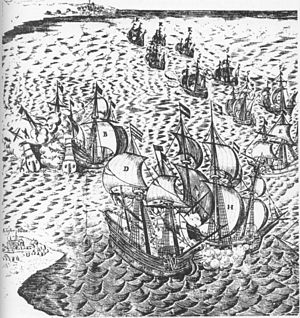| Battle of Oliwa | |||||||
|---|---|---|---|---|---|---|---|
| Part of the Polish–Swedish War (1626–29) | |||||||
 Battle of Oliwa, Filip Janssen | |||||||
| |||||||
| Belligerents | |||||||
|
|
| ||||||
| Commanders and leaders | |||||||
|
|
| ||||||
| Strength | |||||||
|
4 galleons 3 full-rigged pinnaces 3 fluyts |
5 galleons 1 full-rigged pinnace | ||||||
| Casualties and losses | |||||||
| 47 killed or wounded |
304 killed or wounded 47 captured 1 galleon destroyed 1 galleon captured | ||||||


The Battle of Oliwa, also known as the Battle of Oliva or the Battle of Gdańsk Roadstead, was a naval battle that took place on 28 November, 1627, slightly north of the port of Gdańsk off of the coast of the village of Oliva during the Polish–Swedish War. It was the largest naval engagement to be fought by the Polish–Lithuanian Commonwealth Navy and resulted in defeating a Swedish squadron led by Niels Stiernsköld that conducted a blockade of the harbour of Gdańsk. The Poles sailed out of the Gdańsk harbour and engaged the Swedish squadron capturing the Swedish flagship and sinking another Swedish warship.[1]: 110
- ^ Frost, R.I., 2000, The Northern Wars, 1558–1721, Harlow: Pearson Education Limited, ISBN 9780582064294